Introduction
The Australian automotive industry is a small segment of global auto market with no players. There are four major foreign players Australian automotive industry with foreign giants. It has been regarded as an exposed industry due to the international competitive forces and the industry is a shrinking one. Toyota is a Japan based multinational manufacturer of car. Toyota has operation in Australia for producing, marketing and exporting cars for many years Toyota has demonstrated significant effectiveness and efficiency in its Australian operation. The industry has been suffering from structural inefficiencies and passings throw various restructurings.
Furthermore, the competition has drained the consumer preference out to small cars. With major control put forth by Toyota’s head quarter, devolvement of sufficient authority, innovation, and utilization of its production resources, its Australia operation became the industry leader.
Industry Overview
The car industry of Australia is a dynamic one as because it is the only country which has on major domestic car producer. The mostly car producers and all the major car traders are foreign owned and integrated within the industry. But the foreign companies treated their Australian operation as like the other part of the world but not as the country of origin. This problem is creating competitive and quality related troubles, though car manufacturing is one of the major manufacturing industries of Australia. The employment created by this industry is a key area of consideration for the Australian Government for many years. Rather the correlation between the Australian economy and the car manufacturing industry is positive.
The component producers of Australia are mostly domestic based. They export these components to many other countries. Major exports are:
- South Korea- Engines
- United States of America- Braking system, propeller shafts
- Northern America, Japan and China- Mirrors, heating, ventilation and air conditioning products.
- Worldwide- Anti theft system.
In Australia there are 13.2 million motor vehicles running in road. These are mainly petrol powered vehicles. The Australian government has an automotive policy to assist the industry to run effectively and competitively in the domestic and international market.
The four major motor vehicle producers of Australia are:
- Ford
- Holden
- Mitsubishi
- Toyota
The concern of this report would be the Toyota’s operation in Australia which has branded as “Toyota Australia”.
Company background
As a leader in the industry, Toyota Australia has direct and indirect contribution to the Australian industry in employment, capital investment, and purchasing and export revenue. Toyota Australia is a part and wholly owned subsidiary of Toyota Motor Corporation (TMC). This mother firm helps the subsidiary by providing technologies and innovative ideas and their design and production process knowledge. Toyota Australia has 4676 employees and has created employment for many others as to link with the suppliers and the dealers.
The vision of the firm is to become the most respected and most admired company. Its mission is to provide exceptional automotive products, components and services to the customers and to improve the society, partners and environment.
The corporate headquarter of Toyota Australia are situated in Port Melbourne, Victoria. It has manufacturing unit in Altona. In Sydney, New South Wales’s, Woolooware bay it has the sales and marketing unit. It has also sales and distribution centers in all mainland of Australia.
Toyota Australia maintains the guiding principles of Toyota strictly. These principles are:
- Respect the language and guts of the rule of every nation and undertake open and reasonable corporate activities to be a good citizen of the world.
- Admire the culture and customs of every nation and add to economic and social development through corporate activities in the community.
- Give ourselves to provide fresh and secure products and to enriching the quality of life all over the place through all actions.
- Generate and expand superior technologies and supply exceptional products and services that accomplish the needs of customers worldwide.
- Promote a corporate culture that augment personal creativity and teamwork, while exaltation mutual trust and admire between labor and management.
- Pursue expansion in agreement with the universal community through innovative management.
- Work with business partners in research and creation to attain steady, long-term growth and mutual benefits while keeping ourselves open to new partnerships.
Toyota Australia has memberships of different organisation like Australian Industry group, Business council of Australia and many more.
The organizational chart of Toyota Australia is:
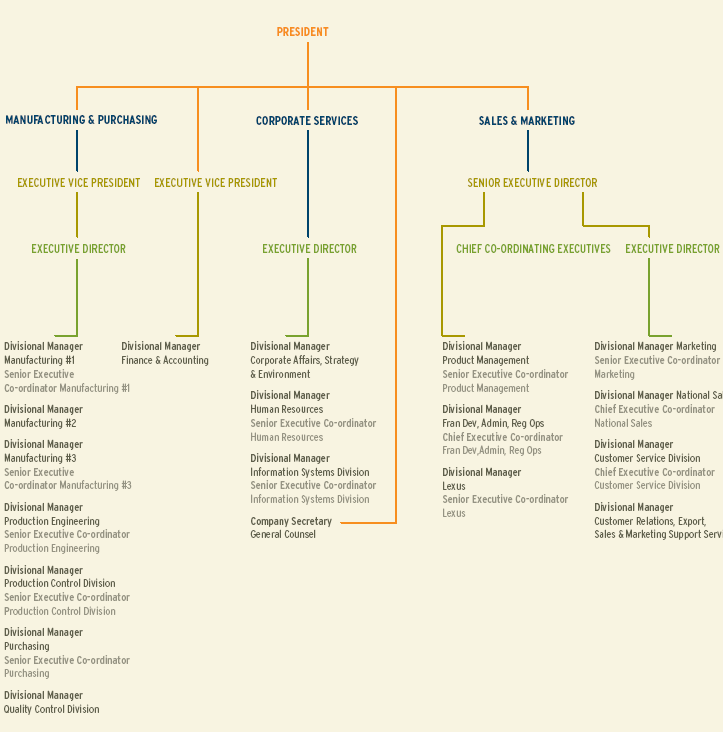
Define and Map the Market
The customers of Toyota Australia are of different kinds. From professionals to the students, business tycoons to government employees all are the customers of Toyota. These customers varied in the basis of two basic dimensions. These are the income of the customer and the present level of life span.
These customers have different needs regarding buying cars. Some people prefer the design, some prefer stability, some prefer space of the car, some prefer proper mileage and some prefer quality of the service. These needs are basically of two types. These are price related needs and the quality related needs.
The market has been defined based on these customer needs. Thus the automotive industry of Australia is driven by customers and the operations are totally customer oriented. The solutions have been derived from many results which has added value add by creation of employment and Innovation.
The market has an industry value added nearly of 4.7 billion USD. It has the potentials to meet customer needs with its ultimate value adding power.
Another solution is the creation of employment for the people of the Australia. There are about 70,000 people employed by the industry. This can be a solution in the sense that the customers have a positive attitude towards the cars of Toyota and think it as a nation friendly organisation.
Firms like Toyota, frequently innovates different kinds of ideas to ensure the customer demand congregate. The research and development sector of Toyota always work hard to find out the new emerged demands of customers and innovate techniques to meet the demands. For these Toyota always keeps its effort to innovate a wide range of different cars within four basic segments. These are:
- Passenger vehicle: Yaris, Corolla, Prius, Camry, Aurion, Aurion Presara, Avensis, Tarago.
- 4WD & SUV vehicle: RAV4, Kluger, Prado, LandCruiser 200.
- Commercial vehicle: Hilux, LandCruiser 70, HiAce, Coaster.
- TRD vehicles: TRD Aurion, TRD Aurion 3500SL, TRD HiLux, TRD HiLux 4000SL.
The industrial value chain is the presentations of upper and downstream link. The value chain consists:
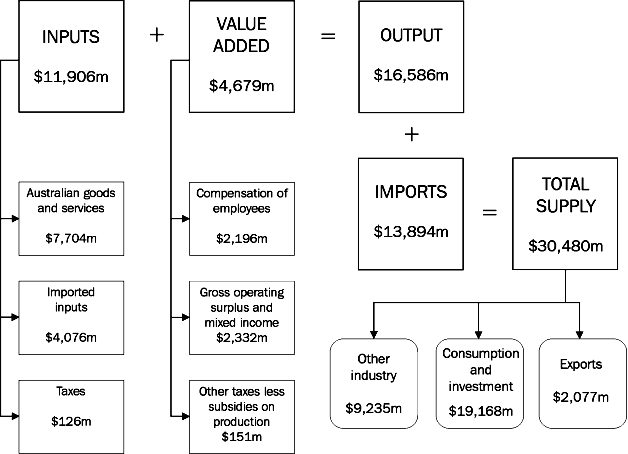
This chart represents that the almost 655 inputs are generated from the domestic production and the rest 35% are from import. These inputs are raw materials like iron and steel, rubber products, core non ironic metals and paints. The value chain interprets the value addition is almost 30%.
These are the pictures of all producers to all customers through all channels. The map of the market can be defined as the distribution of the products and the value chain between the supplier and the final user. In this case the market map may be:
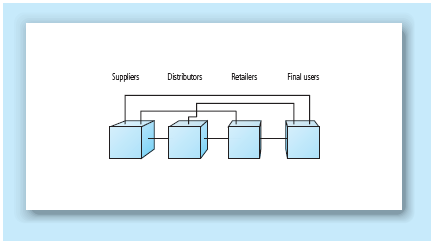
Identify the Customer
The identification of customer is based on some research works. The research and development department continuously studying different customer segments to find new customer segments. The segmentation are done through the measurement of capabilities of Toyota to provide first-class customer service, working equally with the partners in a friendly way to ensure customer satisfaction and design the retail and dealership relationship to reach all customers within the possible shortest time.
The customers of Toyota are of three types. These are the customers who buy cars when they need the business entities and the government and the people who love to get the new versions of latest innovation.
Key players: The key players in the value chain are:
- The employees: there are a mix of culture, age, beliefs and religion among the employees of the Toyota Australia. Toyota always awake to earn the ultimate employee satisfaction. The employee satisfaction index for the last 8 years are shown bellow:
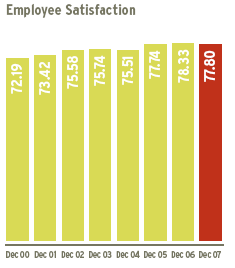
- The customers: Toyota Australia tries to get the proper feedbacks from its customer. In the last year more than 63,174 customers had contacted with the feedback finding section of Toyota named “Customer First department”.
- The business partners: Toyota Australia perceives a different meaning regarding business partner. They treated their suppliers, their retailers and their distributors as their business partner. Toyota Australia has 2000 suppliers and 211 dealers with 66 branches. The satisfaction of these business partners and the relationship with them are also shape the operation of Toyota Australia.
- The entire community: As the operation of Toyota has great impact in the society of Australia, It thinks that it has some duties to perform for the betterment of the society. For this, Toyota Australia has good relationship with the citizens through local partnership and national partnerships.
Process and basis of supplier selection
Toyota Australia believes that the suppliers must be of local origin. They choose the supplier from the Australia to incur self-reliance and improve the Australian community. Thus, it terms the relationship with the suppliers as partnership. The basis of supplier selection is to minimise the gap between the local and global best practice of supply. It provides the sustainability to the suppliers and develops the management skills for the suppliers.
The decision making process
The decision making process is the combination of the steps regarding taking the ultimate final purchasing decision. There are three distinct but interconnected steps. These are: input stage, process stage and the output stage. The input stage is the identification of needs. Process is the transformation of the inputs into the output by some factors like economic factors, psychological factors and so on. The output is the final decision.
The key decision-makers and influencers
In the case of Toyota Australia the ultimate decision makers are the Board of directors. But the decision making process has followed some influences from the managers of different levels. The researchers and the chief management officers along with the help of the suppliers and the dealers influence the decision making process. Influencers persuade the decision of the board of directors. The key influencers are:
- Employees
- Customers
- Business partners
- Government
- Community
- Toyota Motor Corporation (TMC)
Key Buying Decision Making Criteria
The decision makers are:
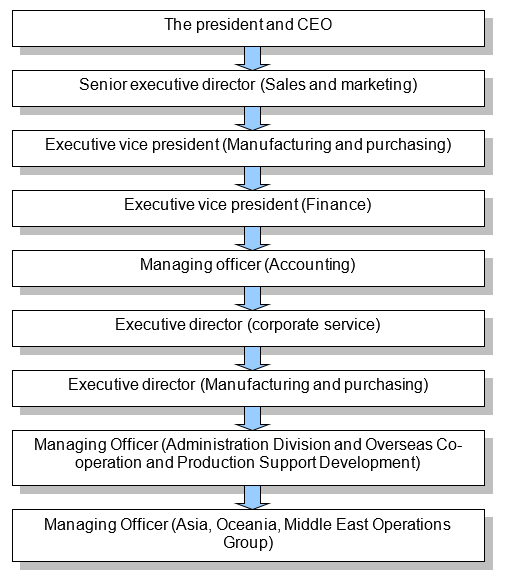
There are two key determining needs for each decision-maker in order of priority. These are the environmental factors and the economic factors.
Environmental factors
- CO2 emission control
- Minimum use of energy
- Emission control of other environmentally harmful components
- Energy efficiency opportunity
- Use of alternative fuel
- Product stewardship
- Proper recycling methods of wastes
Economic factors
- Maximising the profit
- Production and sales of vehicles
- Challenges in the local and foreign manufacturing environment
- Export of raw materials by the local suppliers
- Employee bonus and fringe benefits
- Employee’s occupational health and safety
- Highest customer satisfaction and customer wellbeing
- Customer service; after sales and during sales
Identify and validate Segments
The market segmentation can be done in different basis. These are:
- Geographic segmentation: The buying tendency, preference of characteristics of car and use of car is different between the people of Sydney and Melbourne. These geography based segments indicates that Toyota Australia has customers of all region over the Australia. But in case of population density the major segments can be the highest populated cities like Sydney, Melbourne, Victoria and so on.
- Demographic segmentation: There are differences between the demographics of the customers of Toyota in Australia. In case of age, Toyota has cars for middle aged and aged people from the age limits of 20-65 in general. In case of sex, Toyota has designed its car suitable for both men and women. In case of income, Toyota cars are a little bit moderate price. So, middle and high income people are the targeted segment here. Finally, Toyota innovate different types of cars considering the generation. The new generation is now the target of Toyota as because they need fast and stylish life.
- Psychographic segmentation: The target segment for Toyota based on the psychological factors is the sporty charecterised people and the people who want to have a high image in the society.
- Behavioral segmentation: The people who love to get new stylish cars and to experience the world class quality are the target customers of Toyota. The people who have the tendency to buy cars frequently or experience new and updated products whenever it is available are also the target customers of Toyota.
Customer Value Proposition (CVP)
The target segments of the Toyota are the people aged from 20-65, who want to experience the speed, artistic design and quality.
The customer value proposition of Toyota Australia is the Quality of the cars for the sustainability, reliability and consistency which are coming through the customer satisfaction.
The company should also follow the value- delivery process as-

According to this diagram, Toyota should follow the options as below-
- Analyse of market opportunities.
- Developing marketing strategies,
- Planning marketing programs,
- Managing the marketing effort as-
- Annual planning control
- Profitability control
- Strategic control
- Global expansion control
- Introduction of new and improved model of vehicles,
- Quality development and customer value derived services.
- Efficient cost management endowed as 2004.
- Emerging share and revenue in all operating areas,
- Upward performance at each of the operational criteria.
Positioning Statement
Toyota Australia offers the best quality cars in the Australian car industry for the people who love to experience new technologies, design and facilities and who want to lead a fast speedy life in accordance with the sustainable, reliable and consistent features along with quality.
Marketing Mix
Here are the 4P’s of marketing mix:
- Product: The products of Toyota are of different varieties according to the customer need. The quality, design, features and packaging are of world class. The Brand name has high brand value.
- Price: The price of the cars is moderate. The prices are similar with the global market. Besides, Toyota Australia frequently offers discounts and allowances for the customers. It gives the customers the opportunity to buy in credit with an easier credit policy.
- Place: Toyota Australia has dynamic location plans for its distribution. It uses enlightened distribution channels, coverage, inventory management systems and transportation facilities.
- Promotion: The purpose of the marketing and advertising programs is to create awareness for the products. All these programs are done to keep the position of market leader.
Conclusion
Toyota Australia is operating successfully in Australia through its quality and innovative production of cars. It is capable of meeting the customers needs of various kinds and ensures the maximum profit margin as a subsidiary of Toyota Motor Corporation. Its new product development and marketing programs are the key to its success.
Bibliography
Australian Bureau of Statistics, 2006, Australia’s automotive industry. Web.
Byrne, P. J., 2008. Submission to Automotive Review Secretariat, Department of Innovation, Industry, Science and Research: On the importance of the development of a domestically owned and operated car industry to Australia’s future growth and to solving the nation’s foreign debt crisis. Web.
Drummond, G., Ensor, J. & Ashford, R., 2001, Strategic Marketing: Planning and Control, 2nd edition, Oxford: Butterworth-Heinemann.
Kotler, P. & Keller, K. L., 2006, Marketing management, 12th edition, Prentice Hall, NJ, ISBN: 0-13-0336297.
Perreault, W. D. & McCarthy, E. J., 2002, Basic Marketing: A global Managerial Approach, 14th Edition, McGraw-Hill, Irwin, 2006, ISBN- 0-07-240947-9.
Schiffman, L.G. & Kanuk, L.L. 2007, Consumer Behavior, 9th edition, New Jersey: Pearson Prentice Hall.
Toyota Motor Corporation Australia limited, 2009, 2008 Sustainability Report. Web.
Toyota Motor Corporation limited 2008. Annual Report 2008: Driving to Innovate New Value. Web.
Toyota Motor Corporation Australia, 2002, Submission to Productivity Commission Inquiry into Post 2005 assistance arrangements for the automotive manufacturing sector. Web.
Toyota Australia, 2009, Vehicle. Web.